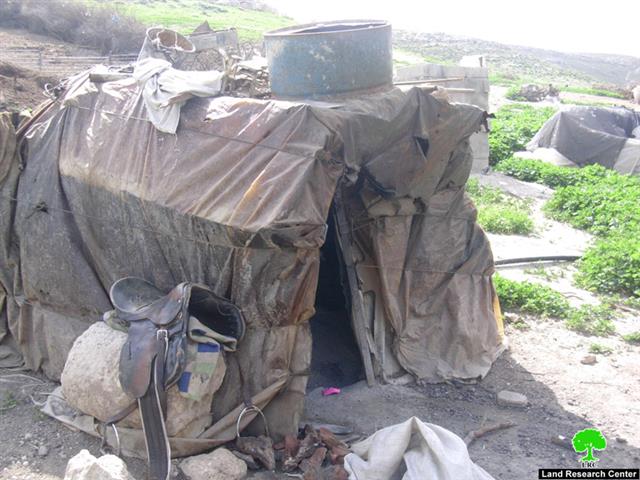On the 4th of March 2009, the residents of Khirbet Al Tawil were once again targeted by Israeli occupation forces in their continuous attempts to uproot Palestinians from that area. It was only in the previous few weeks that these forces distributed Stop Work orders against 5 housing and agricultural structures in Al Khirbet under the pretext of building in area C without a permit.
Up to date, structures (housing and agriculture) in Al Khirbet have received at least 20 Stop Work and Demolition orders. That is in addition to the demolition of a number of tents used to provide shade and protection for the sheep as well as the destruction of water cistern which the residents are prohibited by occupation forces from utilizing and using.
Photo 1: The lifestyle of Khirbet Al Tawil residents.
The Stop Work orders gave the residents until the 26th of March, 2009 to provide “legal permits” in order to stop the demolition procedures. That is despite the fact that the Occupation does not recognize the Khirbet and feverishly refuses to provide any building permit to anyone residing in the Khirbet. The residents of the Khirbet fear that these orders are nothing but a first step in a transfer scheme planned by the occupation forces for the benefit of the expansion of the colonies of Jettit (3 kilometers east of Al Khirbet), Ma’ale Efraym (2.5 kilometers southeast of Al Khirbet) and Elon Moreh (south of the Khirbet).
The following table lists the names of those affected by the Orders and other relevant information:
|
Name
|
Stop Work Orders
|
Type of Structure
|
Area in m2
|
Notes
|
|
Basem Saleem Bani Jaber
|
143203
|
Agricultural room
|
6
|
|
|
143201
|
Agricultural brux
|
24
|
|
|
143204
|
Water cistern
|
Capacity 60 m3
|
|
|
Mohammad
Adnan Rashayda
|
143205
|
Agricultural room
|
8
|
|
|
143202
|
Agricultural brux
|
36
|
|
|
The mosque of Khirbet Al Tawil
|
|
The only mosque in the Khirbet
|
60
|
|
|
TOTAL
|
134
|
|
Khirbet Al Tawil: General Information
The Khirbet is located on Parcel 10 of the town of Aqraba at a distance of 1.5 kilometers from the town’s built-up area. The Khirbet consists of a number of mini-khirbets including those inhabited during the Islamic and even the Roman eras. It contains a number of old cisterns and wells spread throughout its agricultural lands which lends truth to the fact that it’s been inhabited since time immortal. The nature of the climate in the winter season made the lands suitable for winter planting in addition to the availability of grazing areas which encouraged a large number of Aqraba farmers and herders to use its lands and even to live in it. Every resident in Aqraba owns lands in Al Khirbet.
Photo 4: An overview of Khirbet Al Tawil
The most spread crops are wheat, lentils and some vegetables. That is in addition to the fact that herders use the mountainous rugged areas in the spring seasons for their 30,000 sheep and 1500 cows to graze in. As such, Khirebt Al Tawil is considered to be the dairy basket for the entire West Bank and, as such, its loss to the occupation authorities will have far reaching devastating effects.
The area of the khirbet is about 30,000 dunums of agricultural and grazing lands. Around 8,000 dunums of these lands are not suitable for agricultural purposes. There are 15,000 dunums used for agriculture and grazing while 7,000 dunums are used for Israeli colonial purposes. A small portion of the Khirbet is classified as Area B while the overwhelming area is classified as Area C. Israeli colonies established atop Khirebt Al Tawil lands include the following:
|
Colony
|
Year Established
|
Colonist Population (as of 2005)
|
Total Area
(in Dunums)
|
Its Distance from the Green Line
|
|
Jettit
|
1973
|
191
|
1720
|
37 km.
|
|
Ma’ale Efraym
|
1970
|
1423
|
4778
|
——–
|
|
Itamar (extension)
|
1984
|
651
|
7,189
|
28 km.
|
The 500 residents of Khirbet Al Tawil depend mainly on agriculture and herding as the main sources of income. The residents come mainly from Aqraba clans such as Bani Jaber, Bani Omniya, Al Deira, Bani Fadel, Bani Jame’ in addition Al Madayma.
Occupation soldiers and colonists have been harassing the Palestinian farmers and herders of the Khirbet ever since the colonies were established in that area. Chasing off the sheep and cows, the agricultural machinery, taking away the IDs of the farmers, demolition of agricultural bruxes and the destruction of agricultural tents atop their contents are aggressive acts that have been regularly carried out by occupation forces as well as by the colonists. For example, Elon Moreh colonists stole 20 sheep belonging to Mr. Abdulla Abdel Ghani Bani Jaber in the spring of 2007. Moreover, Elon Moreh colonists have continued their aggressive acts to the degree that they have killed a number of shepherds while they were attending to their sheep. The killed shepherds include the 58-year old Mohammad Hamdan Bani Jaber and the 18-year old Yehya Attiya Bani Munia.
In addition to what was mentioned earlier, Israeli occupation soldiers have closed most of the access points into the Khirbet in an attempt to harass those residents living in the vicinity of the colony of Ma’ale Efraym while preventing them from using the water cisterns and grazing fields in the Khirbet.


















